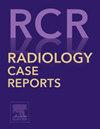法舒地尔动脉内灌注治疗未破裂的大脑中动脉瘤夹闭后出现的症状性脑血管痉挛:1例报告并文献复习
Q4 Medicine
引用次数: 0
摘要
我们报告了第一例已知的有症状的未破裂颅内动脉瘤相关脑血管痉挛(UIA-CVS)手术后夹持,并成功治疗动脉内法舒地尔输注。UIA-CVS是一种罕见的术后并发症,目前尚无标准化的治疗方法。一位67岁的女性在左侧大脑中动脉(MCA)分叉处有5毫米囊性动脉瘤,通过远侧入路行显微外科夹闭手术。术后第7天,患者出现运动性失语。磁共振血管造影和数字减影血管造影显示MCA远端区域明显的血管痉挛。通过微导管连续2天动脉内输注盐酸法舒地尔30mg。血管痉挛迅速消退,神经系统完全恢复。术后5年,患者神经功能完好,无复发。本病例提示,即使在没有蛛网膜下腔出血的情况下,动脉内注射法舒地尔可能是CVS的一种可行治疗方法,强调了早期识别和及时干预术后血管痉挛的重要性。本文章由计算机程序翻译,如有差异,请以英文原文为准。
Intra-arterial fasudil infusion for symptomatic cerebral vasospasm following clipping of an unruptured middle cerebral artery aneurysm: A case report and literature review
We report the first known case of symptomatic unruptured intracranial aneurysm-associated cerebral vasospasm (UIA-CVS) following surgical clipping that was successfully treated with intra-arterial fasudil infusion. UIA-CVS is a rare postoperative complication for which no standardized treatment has been established. A 67-year-old woman with a 5-mm saccular aneurysm at the bifurcation of the left middle cerebral artery (MCA) underwent microsurgical clipping via a distal transsylvian approach. On postoperative day 7, she developed motor aphasia. Magnetic resonance angiography and digital subtraction angiography revealed significant vasospasm in the distal MCA territory. An intra-arterial infusion of fasudil hydrochloride 30 mg was administered over 2 consecutive days via a microcatheter. Rapid resolution of vasospasm and complete neurological recovery were achieved. At 5 years postoperatively, the patient has remained neurologically intact without recurrence. This case suggests that intra-arterial fasudil infusion may be a viable treatment for CVS even in the absence of subarachnoid hemorrhage, underscoring the importance of early recognition and timely intervention in postoperative vasospasm.
求助全文
通过发布文献求助,成功后即可免费获取论文全文。
去求助
来源期刊

Radiology Case Reports
Medicine-Radiology, Nuclear Medicine and Imaging
CiteScore
1.10
自引率
0.00%
发文量
1074
审稿时长
30 days
期刊介绍:
The content of this journal is exclusively case reports that feature diagnostic imaging. Categories in which case reports can be placed include the musculoskeletal system, spine, central nervous system, head and neck, cardiovascular, chest, gastrointestinal, genitourinary, multisystem, pediatric, emergency, women''s imaging, oncologic, normal variants, medical devices, foreign bodies, interventional radiology, nuclear medicine, molecular imaging, ultrasonography, imaging artifacts, forensic, anthropological, and medical-legal. Articles must be well-documented and include a review of the appropriate literature.
 求助内容:
求助内容: 应助结果提醒方式:
应助结果提醒方式:


